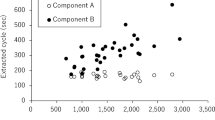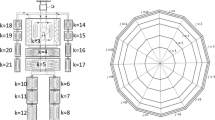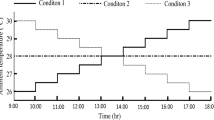Abstract
Defining a thermoneutral environment remains difficult because thermoneutrality depends on both physical and physiological factors. A servocontrolled skin temperature derivative (SCS) heating device has been designed to control the thermal environment in closed incubators without the necessity of setting an air or skin reference temperature. The thermal environment obtained with the SCS program is controlled only by the neonate's skin temperature changes. For each neonate, the program allows the attainment of a specific individual thermal equilibrium (Teq). Although the mean value of the thermal equilibrium level measured on 29 neonates does not differ significantly from the neutral air temperature defined from the charts of other researchers, individual values of Teq differed greatly among neonates of similar birthweight and postnatal age. When compared with on/off heating programs, the SCS system permits greater quiet sleep occurrence and seems to provide an optimal thermal environment. The results suggest that the skin temperature derivative heating program takes into account both the ambient and physiological factors affecting body temperature regulation of each neonate.
Similar content being viewed by others
References
Adamsons, K. J., Gandy, G. M. andJames, L. S. (1965): ‘The influence of thermal factors upon oxygen consumption of the newborn human infant,’J. Pediatr.,66, pp. 495–508.
Bach, V., Bouferrache, B., Kremp, O., Maingourd, Y. andLibert, J. P. (1994): ‘Regulation of sleep and body temperature in response to exposure to cool and warm environments in neonates,’Pediatrics93, pp. 789–796
Brück, K. (1961): ‘Temperature regulation in the newborn infant,’Biologia Neonatorum,3, pp. 65–119
Brück, K., Parmelee, A. H. andBrck, M. (1962): ‘Neutral temperature range and range of ‘thermal comfort’ in premature infants,’Biol. Neonate,4, pp. 32–51
Curzi-Dascalova, L. andMirmiran, M. (1996): ‘Manual of methods for recording and analyzing sleep-wakefulness states in preterm and full-term infant’, (Eds) p. 162
Ducker, D. A., Lyon, A. J., Russel, R. R., Bass, C. A. andMcIntosh, N. (1985): ‘Incubator temperature control effects on the very-low-birth weight infant,’Arch. Dis. Child.,60, pp. 902–907
Geisser, S. andGreenhouse, S. W. (1958): ‘An extension of Bor's results on the use of the F distribution in multivariate analysis’,Ann Math. Stats,29, pp. 885–891
Glass, L., Slverman, W. A. andSinclair, J. C. (1968): ‘Effect of the thermal environment on cold resistance and Growth of small infants after the first week of life,’Pediatrics,41, pp. 1033–1046
Hammarlund, K., Sedin, G., andStromberg, B. (1982): ‘Transepidermal water loss in newborn infants. VII. Relation to post-natal age in very pre-term and full-term appropriate for Gestational age infants,’Acta Paediatr. Scand.,71, pp. 369–374
Heim, T. (1981): ‘Homeothermy and its metabolic cost,’ in DAVIS, and DOBBING, (Eds) ‘Scientific Foundations of Paediatrics’, (Heinemann) pp. 91–128
Hey, E. N. (1969): ‘The relation between environmental temperature and oxygen consumption in the new-born baby’,J. Physiol. (London),200, pp. 589–603
Hey, E. N. (1971): ‘The care of babies in incubators’, inGairdner, D. andHull, D. (Eds) ‘Recent Advances in Pediatrics’, (4th edition, Churchill) pp. 171–216
Hey, E. N. andKatz G. (1970): ‘The optimum thermal environment for naked babies’,Arch. Dis. Child.,45, pp. 328–334
Leblanc, M. H. (1991): ‘Thermoregulation: incubators, radiant warmers, artificial skins, and body hoods,’Clin. Perinatol.18, pp. 403–422
Mestyan, J., Jarai, I., Bata, G. andFekete, M. (1964a): ‘The significance of facial skin temperature in the chemical heat regulation of premature infants,’Biol. Neonate,7, pp. 243–254
Mestyan, J., Jarai, I., Bata, G. andFekete M. (1964b): ‘Surface temperature versus deep body temperature and the metabolic response to cold of hypothemic premature infants’,Biol. Neonate,7, pp. 230–242
Pajot, N., Vicente, G. andDreyfus-Brisac, C. (1976): ‘Techniques d'enregistrement des mouvements oculaires chez le nouveauné: comparaison des méthods,’J. Electrophysiol. Technol.,2, pp. 29–38
Perlstein, P. H., Edwards, N. K., Atherton, H. D., andSutherland, J. M. (1976): ‘Computer assisted newborn intensive care,’Pediatrics,57, pp. 494–502
Perlstein, P. H., Edwards, N. K., andSutherland, J. M. (1970): ‘Apnea in premature infants and incubator-air-temperature changes’,N. Engl. J. Med.,282, pp. 461–466
Putet, G., Dittmar, A., Schimtt, M., andSalle B. (1982): ‘Influence of thermoregulation on energy metabolism of the low birth-weight infant’,Acta Paediatr. Scand.,S 296, pp. 62–66
Rutter, N., Brown, S. M. andHull, D. (1978): ‘Variations in the resting oxygen consumption of small babies,’Arch. Dis. Child.,53, pp. 850–854
Rutter, N. andHull, D. (1979): ‘Water loss from the skin of term and preterm babies’,Arch. Dis. Child.,58, pp. 858–868
Sauer, P. J. J., Dane, H. J. andVisser, H. K. A. (1984): ‘New standards for neutral thermal environment of healthy very low birthweight infants in week one of life,’Arch. Dis. Child.59, pp. 18–22
Scopes, J. W. andAhmed, I. (1966): ‘Minimal rates of oxygen consumption in sick and premature newborn infants,’Arch. Dis. Child.,41, pp. 407–416
Silverman, W. A., Fertig, J. W. andBerger, A. P. (1958): ‘The influence of the thermal environment upon the survival of newly born premature infants,’Pediatrics,22, pp. 876–886
Telliez, F., Bach, V., Krim, G. andLibert, J.-P. (1997): ‘Consequences of a small decrease of air temperature from the thermal equilibrium on thermoregulation in sleeping neonates,’Med. Biol. Eng. Comput.,35, pp. 516–520
Vasey, M. W. andThayer, J. F. (1987): ‘The continuing problem of false positives in repeated measures ANOVA in psychophysiology: a multivariate solution,’Psychophysiology24, pp. 479–486
Winer, G. (1971): ‘Statistical principles in experimental design,’McGraw, andHill (Eds)
Author information
Authors and Affiliations
Rights and permissions
About this article
Cite this article
Telliez, F., Bach, V., Delanaud, S. et al. Skin derivative control of thermal environment in a closed incubator. Med. Biol. Eng. Comput. 35, 521–527 (1997). https://doi.org/10.1007/BF02525534
Received:
Accepted:
Issue Date:
DOI: https://doi.org/10.1007/BF02525534




